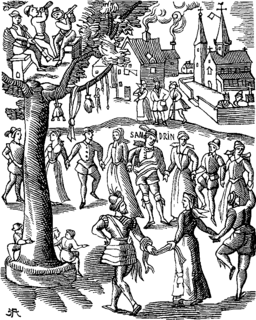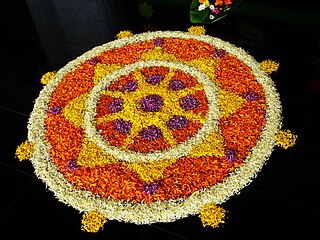Related Research Articles

Easter, also called Pascha or Resurrection Sunday, is a Christian festival and cultural holiday commemorating the resurrection of Jesus from the dead, described in the New Testament as having occurred on the third day of his burial following his crucifixion by the Romans at Calvary c. 30 AD. It is the culmination of the Passion of Jesus Christ, preceded by Lent, a 40-day period of fasting, prayer, and penance.

New Year is the time or day currently at which a new calendar year begins and the calendar's year count increments by one. Many cultures celebrate the event in some manner. In the Gregorian calendar, the most widely used calendar system today, New Year occurs on January 1. This was also the first day of the year in the original Julian calendar and the Roman calendar.

A festival is an event ordinarily celebrated by a community and centering on some characteristic aspect of that community and its religion or cultures. It is often marked as a local or national holiday, mela, or eid. A festival constitutes typical cases of glocalization, as well as the high culture-low culture interrelationship. Next to religion and folklore, a significant origin is agricultural. Food is such a vital resource that many festivals are associated with harvest time. Religious commemoration and thanksgiving for good harvests are blended in events that take place in autumn, such as Halloween in the northern hemisphere and Easter in the southern.
The Hindu calendar, Panchanga or Panjika is one of various lunisolar calendars that are traditionally used in the Indian subcontinent and Southeast Asia, with further regional variations for social and Hindu religious purposes. They adopt a similar underlying concept for timekeeping based on sidereal year for solar cycle and adjustment of lunar cycles in every three years, but differ in their relative emphasis to moon cycle or the sun cycle and the names of months and when they consider the New Year to start. Of the various regional calendars, the most studied and known Hindu calendars are the Shalivahana Shaka(Based on the King Shalivahana, also the Indian national calendar) found in the Deccan region of Southern India and the Vikram Samvat (Bikrami) found in Nepal and the North and Central regions of India – both of which emphasize the lunar cycle. Their new year starts in spring. In regions such as Tamil Nadu and Kerala, the solar cycle is emphasized and this is called the Tamil calendar and Malayalam calendar and these have origins in the second half of the 1st millennium CE. A Hindu calendar is sometimes referred to as Panchangam (पञ्चाङ्ग), which is known also known as Panjika in Eastern India.

Lunar New Year is the beginning of a calendar year whose months are moon cycles, based on the lunar calendar or lunisolar calendar.

Onam is an annual Indian harvest festival celebrated predominantly by the Hindus of Kerala. A major annual event for Keralites, it is the official festival of the state and includes a spectrum of cultural events.

Mesoamerican calendars are the calendrical systems devised and used by the pre-Columbian cultures of Mesoamerica. Besides keeping time, Mesoamerican calendars were also used in religious observances and social rituals, such as for divination.

Pausha is a month of the Hindu calendar and as well in the Indian national calendar; it's the tenth month of the year, corresponding with December/January in the Gregorian calendar.
The term Christianized calendar refers to feast days which are Christianized reformulations of feasts from pre-Christian times.

All Saints' Day, also known as All Hallows' Day, the Feast of All Saints, the Feast of All Hallows, the Solemnity of All Saints, and Hallowmas, is a Christian solemnity celebrated in honour of all the saints of the church, whether they are known or unknown.

The winter solstice, also called the hibernal solstice, occurs when either of Earth's poles reaches its maximum tilt away from the Sun. This happens twice yearly, once in each hemisphere. For that hemisphere, the winter solstice is the day with the shortest period of daylight and longest night of the year, when the Sun is at its lowest daily maximum elevation in the sky. Either pole experiences continuous darkness or twilight around its winter solstice. The opposite event is the summer solstice.

Aztec cuisine is the cuisine of the former Aztec Empire and the Nahua peoples of the Valley of Mexico prior to European contact in 1519.

Festival of the Dead or Feast of Ancestors is held by many cultures throughout the world in honor or recognition of deceased members of the community, generally occurring after the harvest in August, September, October, or November.
Tozoztontli is the name of the third month of the Aztec calendar. It means Little Perforation. It is also a festival in the Aztec religion, the deities are Centeotl, Tlaloque, Chicomecoatl and Coatlicue. It marks the end of the dry season. It is the season of bird sacrifices and is called The Little Vigil.
Quecholli is the name of the fourteenth month of the Aztec calendar. It is also a festival in the Aztec religion and the Principal deity is Mixcoatl. It is called the Precious Feather and hunting is done during this season.
Huey Tozoztli also known as Huey Tocoztli is the name of the fourth month of the Aztec calendar. It is also a festival in the Aztec religion dedicated to Tlaloc and other deities. It is called the great or long vigil.

Tecuilhuitontli is the name of the Seventh month of the Aztec calendar. It is also a festival in the Aztec religion. The principal deity is Xochipilli and feasts are also given to Goddess Huixtocihuatl and it is known as the Small Festival of the Lords.

Tepeilhuitl is the name of the thirteenth month of the Aztec calendar. It is also a festival in the Aztec religion dedicated to Popocatepetl, Iztaccihuatl and Tlaloc. It is called the festival or feast of the Mountains.
Etzalcualiztli is the name of the sixth month of the Aztec calendar. It is also a festival in the Aztec religion dedicated to Tlaloc and Chalchihuitlicue.
Huey Tecuilhuitl also called Uey Tecuilhuitl is the name of the eighth month of the Aztec calendar. It is also a festival in the Aztec religion dedicated to Xilonen and Cihuacoatl. It is called the Great festival of the Lords.
References
- ↑ "Hueymiccaihuitl, Great Feast of the Dead, the Tenth Month of the Aztec Solar Calendar". World Digital Library. Retrieved 21 July 2013.
- ↑ European Society for Astronomy in Culture. Meeting (1996). Astronomical traditions in past cultures: proceedings of the first Annual General Meeting of the European Society for Astronomy in Culture (SEAC), Smolyan, Bulgaria, 31 August-2 September 1993. Institute of Astronomy, Bulgarian Academy of Sciences. p. 171. ISBN 978-954-90133-1-3 . Retrieved 21 July 2013.
- ↑ Traditional festivals. 2. M - Z. ABC-CLIO. pp. 204–. ISBN 978-1-57607-089-5 . Retrieved 24 July 2013.
- ↑ "The Aztec Festivals". www.amoxtli.org. Archived from the original on 21 August 2013. Retrieved 24 July 2013.